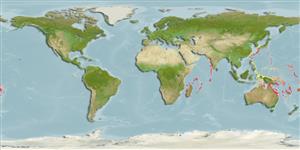Common names from other countries
Classification / Names / Names
Common names | Synonyms | Catalog of Fishes (gen., sp.) | ITIS | CoL | WoRMS
Environment: milieu / climate zone / depth range / distribution range
Ecology
Benthic; depth range 1 - 13 m (Ref. 99368). Subtropical
Indo-Pacific.
Length at first maturity / Size / Weight / Age
Maturity: Lm ? range ? - ? cm Max length : 0.9 cm BL male/unsexed; (Ref. 8031)
Maximum depth is based on occurrence in French Polynesia (Ref. 99368); to be replaced with a better reference. Minimum depth assumed from its ecology (Ref. 99368). Inhabits an outer reef slope (Ref. 99368).
Life cycle and mating behavior
Maturity | Reproduction | Spawning | Eggs | Fecundity | Larvae
This species is a non-broadcast spawner. Life cycle does not include trocophore stage. Also Ref. 833.
deMaintenon, M. 1990. (Ref. 8031)
IUCN Red List Status (Ref. 130435)
CITES status (Ref. 108899)
Not Evaluated
Not Evaluated
Human uses
| FishSource |
Tools
More information
Age/Size
Growth
Length-weight
Length-length
Morphology
Larvae
Abundance
Internet sources
Estimates based on models
Preferred temperature
(Ref.
115969): 22.6 - 27.2, mean 25.9 (based on 473 cells).
Vulnerability
Low vulnerability (10 of 100).
